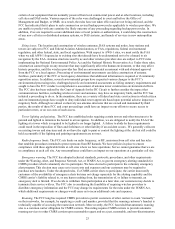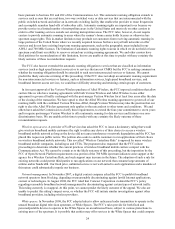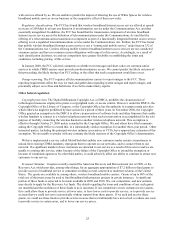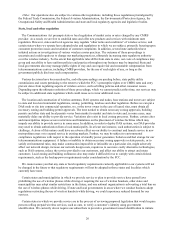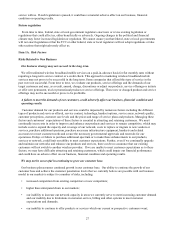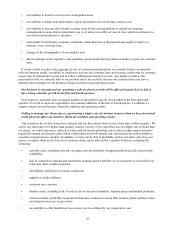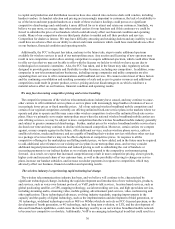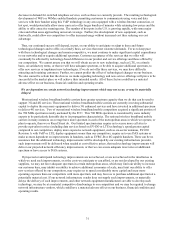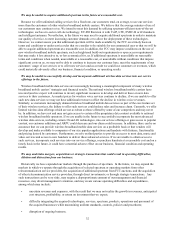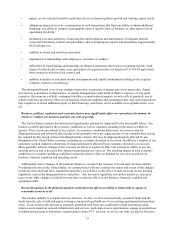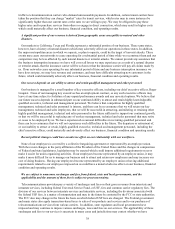Metro PCS 2008 Annual Report Download - page 39
Download and view the complete annual report
Please find page 39 of the 2008 Metro PCS annual report below. You can navigate through the pages in the report by either clicking on the pages listed below, or by using the keyword search tool below to find specific information within the annual report.30
to capital and production and distribution resources have also entered into exclusive deals with vendors, including
handset vendors. As handset selection and pricing are increasingly important to customers, the lack of availability to
us of the latest and most popular handsets as a result of these exclusive dealings could put us at a significant
competitive disadvantage and could make it more difficult for us to attract and retain our customers. Similarly, we
believe we pay more, on average, than other national carriers for our handsets and if this continues we could be
forced to subsidize the price of our handsets which could adversely affect our financial condition and operating
results. Many of our competitors also use third party dealers to market and sell their products and services.
Competition for dealers is intense. We may have difficulty attracting and retaining dealers and any inability to do so
could have an adverse effect on our ability to attract and retain customers which could have material adverse effect
on our business, financial condition and operating results.
Additionally, the FCC in the past has taken, and may in the future take, steps to make additional spectrum
available for wireless services in each of our metropolitan areas. Any auction and licensing of new spectrum may
result in new competitors and/or allow existing competitors to acquire additional spectrum, which could allow them
to offer services that we may not be able to offer with the licenses we hold or to which we have access due to
technological or economic constraints. Also, the FCC has taken, and in the future may take, regulatory actions
designed to provide greater capacity and flexibility to other licensees, including our competitors. In addition, some
companies in non-telecommunications businesses, including energy companies and utility companies are also
expanding their services to offer communications and broadband services. We cannot control most of these factors
and the continuing consolidation and resulting economies of scale and access to greater resources and additional
competition could result in greater product, service, pricing and cost disadvantages to us which could have a
material adverse affect on our business, financial condition and operating results.
We may face increasing competitive pricing and service bundling.
The competitive pressures of the wireless telecommunications industry have caused, and may continue to cause,
other carriers to offer unlimited service plans or service plans with increasingly large bundles of minutes of use at
increasingly lower prices or fixed monthly prices. All of our national wireless broadband mobile competitors and
certain of our regional competitors currently are offering unlimited fixed-rate service plans in the markets where we
operate and plan to operate and this may cause other wireless competitors to also offer unlimited fixed-rate service
plans. Since we primarily serve major metropolitan areas where the national wireless broadband mobile carriers are
also offering services, we may be subject to more competition than the wireless broadband mobile industry generally
and subject to greater commercial disadvantage. Further, market prices for wireless broadband mobile services have
declined over time and may continue to decline with increased competition. Moreover, certain carriers we compete
against, or may compete against in the future, offer additional services, such as wireline phone service, cable or
satellite television, media and Internet, and are capable of bundling their wireless services with these other services
in a package of services that we may not be able to duplicate at competitive prices. In response to all the
competitive offerings in the marketplace and falling market prices, we have added, and in the future may be required
to add, additional select features to our existing service plans in our metropolitan areas, and we may consider
additional targeted promotional activities and reduced pricing as well as subsidizing the cost of handsets or
increasing payments to our indirect dealers as we evaluate and respond to the competitive environment going
forward. As a result, we expect that increased competition may result in more competitive pricing, slower growth,
higher costs and increased churn of our customer base, as well as the possibility of having to change our service
plans, increase our handset subsidies, and increase our dealer payments in response to competition, which may
adversely affect our business, financial condition and operating results.
The wireless industry is experiencing rapid technological change.
The wireless telecommunications industry has been, and we believe will continue to be, characterized by
significant technological change, including the rapid development and introduction of new technologies, products,
and services, such as voice-over Internet protocol, or VoIP, push-to-talk services, location based services, such as
global positioning satellite, or GPS, mapping technology, social networking services, and high speed data services,
including streaming audio, streaming video, mobile gaming, advertisement paid services, video conferencing and
other applications. These technological advances, evolving industry standards, ongoing improvements in the
capacity and the quality of digital technology, such as the implementation and development of third generation, or
3G technology, wideband technologies such as WiFi or WiMax which do not rely on FCC-licensed spectrum, or the
development of fourth generation, or 4G technology, such as long term evolution, or LTE, and the development of
data and broadband capabilities, could cause the technology used by us on our wireless broadband mobile network
to become less competitive or obsolete. Additionally, VoIP is an emerging technological trend that could result in a





